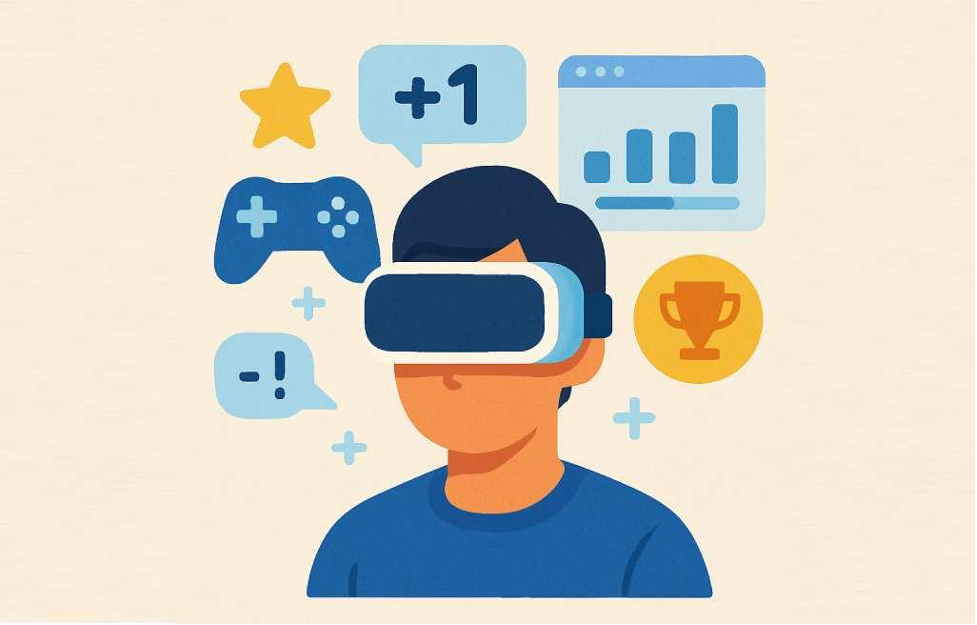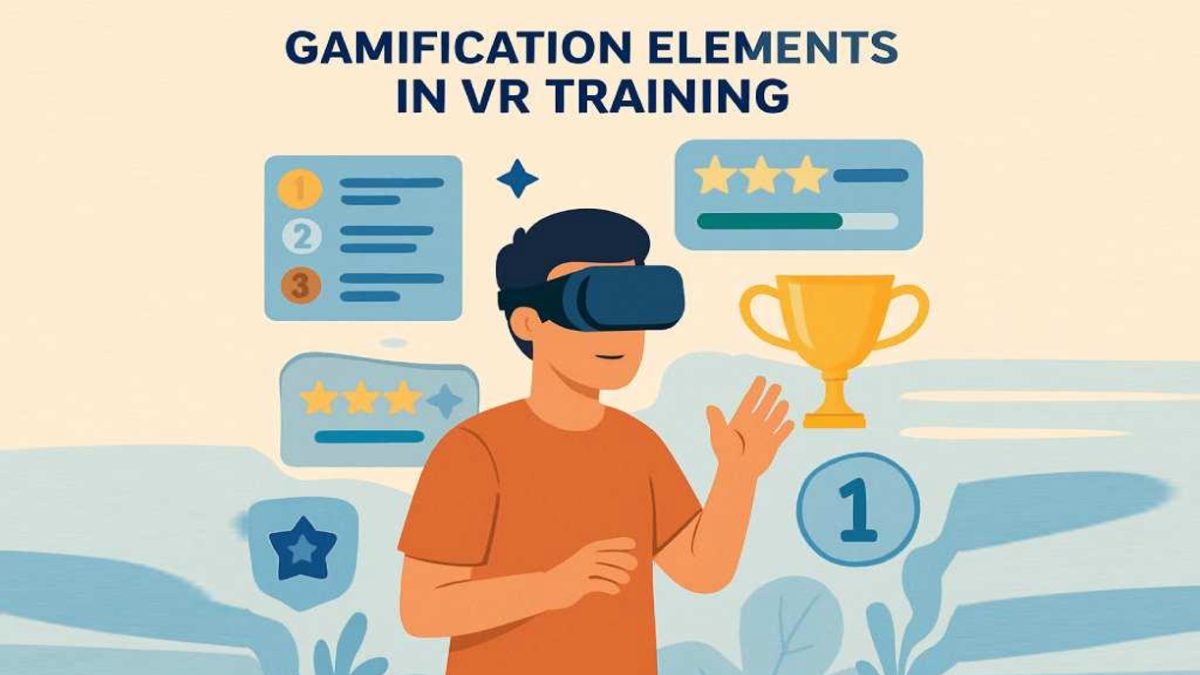Gamification in education enhances learner engagement by integrating game elements into the learning process. This concept has gained traction in various fields, including virtual reality application development.
As organizations leverage VR for training, the need for effective gamification strategies grows. When done correctly, gamification in VR training simulators can significantly boost motivation and retention. In this article, we’ll explore how to implement gamification effectively in VR training environments.
Gamification is the use of game design features in settings that are not games. When used in VR training, gamification enhances the learning experience by making it more engaging and immersive. This is done by adding features like points, badges, leaderboards, and storytelling to training activities. The aim is to use the motivating aspects of games to create a better learning environment. Knowing these features is important for creating VR training programs that are truly helpful for learners.
The Role of Gamification in Education and Training
Gamification in education is not a new idea, but using it in VR training is still quite recent. VR’s immersive nature offers a fresh way to engage learners that traditional methods can’t match. By creating realistic environments and situations, VR training with game-like elements can boost thinking and motor skills, enhance problem-solving abilities, and promote active involvement. This method takes advantage of VR’s unique experiences, making learning both effective and fun.
The main goal of using gamification in VR training is to make the experience interesting and engaging. This helps users stay motivated as they learn. With instant feedback and clear rewards, learners are more likely to stay involved and work towards their training goals. Keeping this level of engagement is important for helping them remember what they learned and use those skills in real-life situations.
Medical VR Training: Enhancing Healthcare Education
Medical VR training is a strong tool for improving healthcare education. It lets students and professionals practice complex procedures in a safe setting. One new method is using medical VR game scenarios. These add game-like features to make learning more interesting and motivating. Learners can earn points, unlock achievements, or get rewards for completing surgical tasks or diagnosing virtual patients.
The immersive experience of VR enables healthcare professionals to refine their techniques without risk to real patients. Medical VR game environments can simulate high-pressure scenarios, helping build confidence and preparedness for real-world medical practice. These interactive simulations not only enhance technical skills but also improve decision-making under stress.
Immediate feedback during training helps learners identify strengths and areas for improvement, accelerating their learning curve. By incorporating gamification and medical VR game mechanics, educational institutions can create more effective and engaging learning experiences, ultimately improving patient care and safety.
Benefits of Gamification in VR Training
Gamification in VR training has many benefits. First, it boosts learner motivation by adding fun and competition. When learners are motivated, they tend to put in more time and effort, which leads to better results. Second, gamification helps improve retention rates by making the training content more engaging and memorable. When learners enjoy what they are doing, they are more likely to remember the information later.
Gamification in VR training helps learners understand complex ideas better. By using gamified elements, they can explore various scenarios and outcomes. This leads to a clearer understanding of the subject. This interactive method is especially helpful for difficult topics that need more engagement to learn.
Challenges in Implementing Gamification
Gamification in VR training has clear benefits, but it can be hard to implement well. One big challenge is making sure that game-like features don’t take attention away from learning goals. It’s important to find a balance between fun and education, so that learning skills and knowledge stays the main focus. Also, creating gamified experiences for different learning styles can be complicated and needs careful planning based on what learners want and need.
Another challenge is keeping the technology needed for VR training up to date. Good VR experiences need a lot of resources, like hardware, software, and tech support. Organizations must make sure they have the right infrastructure to provide a smooth gaming experience. Also, they need to regularly monitor and update their training programs to keep them useful and effective.
Key Elements of Gamification in VR Training

To effectively implement gamification in VR training simulators, it is essential to understand the key elements that contribute to a successful gamified experience. These elements include:
Points and Rewards
Points and rewards are key parts of gamification. They help learners feel accomplished and make them want to keep learning. In virtual reality (VR) training, learners can earn points for finishing tasks, solving problems, or hitting certain goals. Rewards like badges or virtual items can boost motivation by showing success in a clear way. This system allows learners to see their progress and set goals for doing better.
Points and rewards also encourage competition among learners, which can further drive engagement. By comparing their achievements with peers, learners may feel motivated to improve their performance, fostering a healthy competitive environment. This element of competition should be designed thoughtfully to ensure that it remains friendly and inclusive, promoting collaboration alongside individual achievement.
Additionally, the use of rewards can be tailored to the specific needs of the learners. For example, learners who prefer social recognition might value leaderboards, while others might be more motivated by personal achievements. Understanding these preferences can help in designing a reward system that effectively motivates all learners.
Challenges and Levels
Incorporating challenges and levels into VR training can create a structured learning path that gradually increases in complexity. By presenting learners with progressively difficult tasks, they are encouraged to develop their skills and knowledge incrementally. This approach not only enhances engagement but also fosters a sense of accomplishment as learners advance through the levels. The sense of progression can be a powerful motivator, encouraging learners to continue despite difficulties.
Challenges should be designed to be attainable yet sufficiently challenging to stimulate growth. This balance is crucial; if tasks are too easy, learners may lose interest, while overly difficult tasks may lead to frustration. The key is to design challenges that are aligned with the learners’ current skill levels while pushing them to improve. This incremental learning process can build confidence and ensure that learners are well-prepared for more advanced tasks.
Moreover, the level-based structure can provide clear milestones, helping learners to see their progress and set future goals. These milestones can be celebrated with rewards or recognition, further motivating learners to continue their journey. By clearly defining the path to mastery, learners can focus their efforts more effectively and achieve better outcomes.
Storytelling and Narrative
A well-crafted narrative can significantly enhance the gamified experience by providing context and meaning to the training exercises. By embedding the training material within a compelling story, learners are more likely to become emotionally invested in the experience. This emotional engagement can lead to improved retention and application of the knowledge and skills acquired during training. Stories can make abstract concepts more relatable, helping learners to connect with the material on a deeper level.
Storytelling in VR training can take many forms, from a simple scenario-based approach to complex narratives that evolve over time. These narratives can create an immersive experience that captivates learners, making the learning process enjoyable and memorable. The use of characters, plotlines, and settings can add depth to the training material, making it more engaging and impactful.
Furthermore, narratives can be designed to reflect real-world scenarios, allowing learners to practice decision-making and problem-solving in a controlled environment. By simulating realistic situations, learners can gain valuable insights and experience, preparing them for similar challenges in their professional roles. The use of storytelling can transform training from a mundane task to an exciting journey, enhancing both engagement and learning outcomes.
Feedback and Progress Tracking
Immediate feedback is a crucial component of effective learning. In VR training, real-time feedback can be provided through visual or auditory cues, helping learners understand their performance and identify areas for improvement. Progress tracking, such as leaderboards or progress bars, can also motivate learners by allowing them to see their advancement over time. This visibility into their progress can help learners stay focused and motivated, setting clear goals for improvement.
Feedback should be constructive, providing learners with actionable insights into their performance. By highlighting strengths and identifying areas for improvement, feedback can guide learners in refining their skills and knowledge. This process can be enhanced with personalized feedback, tailored to the individual needs and preferences of each learner.
Progress tracking can also foster a sense of accountability, encouraging learners to take ownership of their learning journey. By regularly reviewing their progress, learners can identify patterns, set new goals, and adjust their strategies as needed. This continuous cycle of feedback and self-reflection can lead to significant improvements in performance and learning outcomes.
Implementing Gamification in VR Training Simulators
The implementation of gamification of virtual reality training requires careful planning and consideration to ensure that the gamified elements align with the training objectives and enhance the learning experience. Here are some key steps to consider:
Define Clear Objectives
Before incorporating gamification into VR training, it is essential to define clear learning objectives. These objectives should guide the selection and design of gamified elements to ensure that they effectively support the desired learning outcomes. Clearly defined objectives provide a framework for evaluating the success of the gamification strategy, ensuring that it aligns with the overall training goals.
Objectives should be specific, measurable, achievable, relevant, and time-bound (SMART) to ensure that they are meaningful and attainable. By setting clear goals, trainers can focus their efforts on designing gamified experiences that truly benefit learners. These objectives also provide a basis for assessing the effectiveness of the training program, guiding future improvements.
Moreover, involving stakeholders in the objective-setting process can ensure that the gamification strategy meets the needs of all parties involved. By aligning objectives with organizational goals and learner needs, trainers can create a more effective and impactful training program.
Design Engaging Scenarios
The design of the training scenarios should be engaging and relevant to the learners’ real-world tasks and challenges. By creating immersive environments that mirror actual work situations, learners can practice and apply their skills in a safe and controlled setting. Realistic scenarios provide learners with opportunities to explore different approaches and solutions, enhancing problem-solving skills and confidence.
Scenarios should be designed to be interactive, allowing learners to actively participate in the learning process. This interactivity can be achieved through the use of simulations, role-playing, and decision-making tasks. By engaging learners in meaningful activities, scenarios can foster deeper understanding and retention of the training material.
Additionally, scenarios should be designed to accommodate different learning styles and preferences. By offering a variety of activities and challenges, trainers can ensure that all learners can engage with the material in a way that suits them best. This approach can lead to more effective and inclusive training experiences.
Integrate Game Mechanics
The integration of game mechanics, such as points, levels, and storytelling, should be carefully balanced to enhance engagement without detracting from the learning objectives. It is important to ensure that the gamified elements are meaningful and relevant to the training material. By aligning game mechanics with the learning objectives, trainers can create a cohesive and impactful training experience.
Game mechanics should be designed to complement the training content, enhancing rather than overshadowing it. This balance can be achieved by focusing on the educational value of each gamified element, ensuring that it supports the overall training goals. By integrating game mechanics thoughtfully, trainers can create an engaging and effective learning environment.
Furthermore, the use of game mechanics should be flexible, allowing for adjustments based on learner feedback and performance. By continuously monitoring and refining the gamification strategy, trainers can ensure that it remains relevant and effective. This iterative approach can lead to continuous improvements in the training program, resulting in better learning outcomes.
Monitor and Evaluate
The effectiveness of gamified VR training solutions should be continuously monitored and evaluated. By collecting and analyzing data on learner performance and engagement, trainers can identify areas for improvement and make necessary adjustments to the training program. This ongoing evaluation process is crucial for ensuring that the gamification strategy remains effective and aligned with the training objectives.
Evaluation should be based on both qualitative and quantitative data, providing a comprehensive view of the training program’s impact. By gathering feedback from learners, trainers can gain insights into their experiences and preferences, guiding future improvements. Additionally, performance metrics can provide valuable information on the effectiveness of the gamified elements, helping trainers to refine and enhance the training program.
Regular evaluation and feedback loops can lead to continuous improvements in the training program, ensuring that it remains relevant and effective. By adopting a proactive approach to evaluation, trainers can create a dynamic and impactful gamification strategy that meets the needs of all learners.
Conclusion
Using VR-based gamified learning simulators can greatly improve how people learn. These simulators make training more engaging by using game-like features, which can motivate learners to reach their goals. However, to be successful, it is important to plan carefully. The game elements need to fit with the training goals and truly help with learning. As VR training develops, gamification will likely become more important in the future of education and training.
By using gamification, organizations can make training programs more engaging and effective. With careful planning and regular assessment, gamification can improve learning results and help learners face modern workplace challenges. The future of VR training looks promising, and gamification will play an important role in this development.

